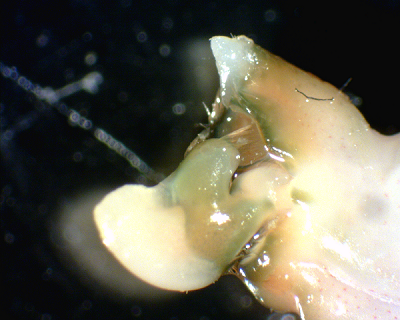(Versluis
et al. 2000)

Photo of
Alpheus Parvirostris largest chelae, with the claw in an open (locked) state. Note the rounded plunger (centre of photo) and its matching excavation (above plunger). Original Photo Aidan Janetzki 2013.
Snapping shrimp are thought to 'snap' for two reasons. Firstly, they have been observed to stun or kill small fish by snapping their large chela in the fishes vicinity. The fish are then preyed upon, and make up a stable diet for many species of snapping shrimp (Versluis
et al. 2000). Secondly, snapping shrimp use their snapping mechanism as a defence mechanism either against predatory organisms such as errant annelids or against other shrimp of the same species. Such behaviour was observed on Heron Island, where shrimp were placed in a confined area, such that their numbers were much more concentrated than would would likely be the case in the wild. This action brought upon regular snapping , particularly amplified as the females were currently carrying eggs and were likely to be more aggressive towards other shrimp.
Video of Alpheus parvirostris creating the snapping sound. Original Video Aidan Janetzki 2013.